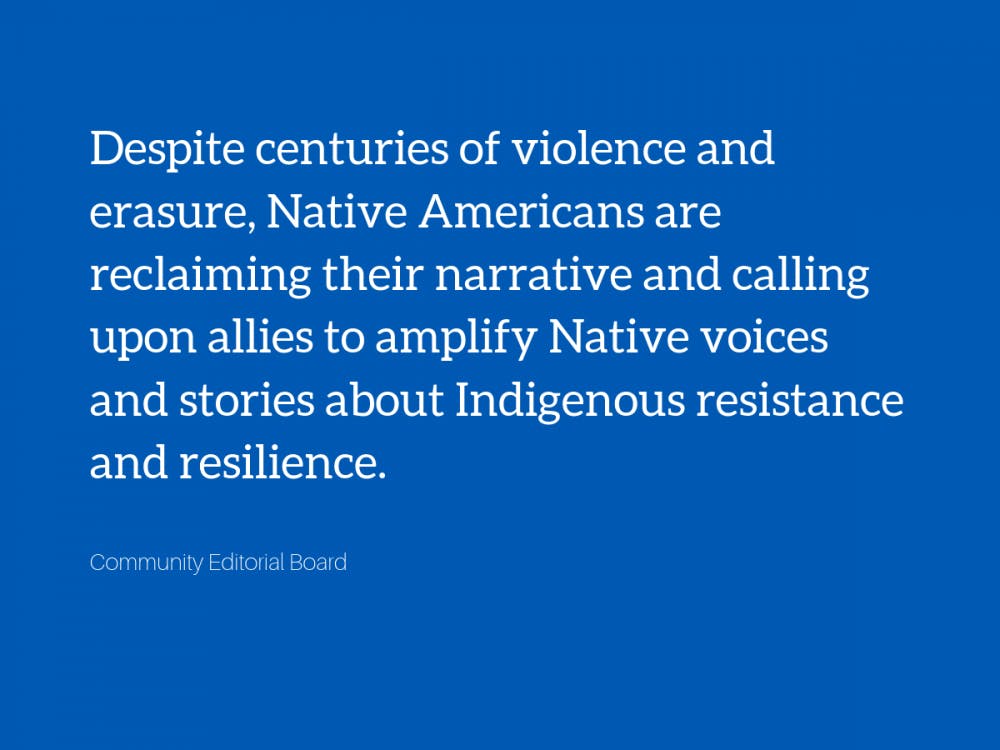The members of the Community Editorial Board are independent of the Chronicle’s editorial staff.
More than half a millennium ago, in 1492, Christopher Columbus sailed the ocean blue—as the common elementary poem goes. This past Monday, the federally recognized holiday Columbus Day celebrated his arrival to and discovery of the Americas. What the poem and the holiday fail to reflect, however, is how Columbus got lost and ended up on Indigenous land only to leave in his wake horrifying and devastating legacies of mass genocide, rape and sexual exploitation, enslavement and land seizure. To correct the gross celebration of genocidal settler colonialism and to instead recenter Indigenous histories and communities, many states and cities have moved towards the celebration of Indigenous Peoples’ Day instead.
Historical commemorative holidays usually look back and reflect upon the past. In this shift, it is important to note that Indigenous Peoples’ Day is not only a recognition of and reflection on history, but also a reckoning with the ongoing and invisible issues that Native Americans face. Today, there are more than five hundred federally recognized Indigenous nations that makes up nearly three million people, descendants of the fifteen million Native people who once inhabited the United States. As a result of land seizures of over 1.5 billion acres, isolation by reservations and environmental destruction, Native Americans experience high poverty and incarceration rates, low educational attainment and alarming health disparities related to diabetes, alcohol-related and drug-induced deaths.
Despite centuries of violence and erasure, Native Americans are reclaiming their narrative and calling upon allies to amplify Native voices and stories about Indigenous resistance and resilience. However, the few Indigenous news stories that make it onto timelines and news feeds tend to be based on stereotypes or only relevant to allies that find common ground with certain issues such as environmental justice. This is convenient for liberals who already believe in environmental preservation and sustainable land use and subsequently co-opt the movement. Meanwhile, these ‘allies’ remain willfully or unintentionally silent around issues that do not directly impact them, contributing to the erasure of the multifaceted Indigenous experiences.
On Monday, Oct. 14, 2019, the only readily available recognition of Indigenious Peoples’ Day from Duke University could be found in a tweet from the Duke University Archives’ Twitter page. Although it may be little known, there exists a valuable long-standing history and presence of Native Americans at Duke that deserves much greater recognition. Beneath the glass boxes and beyond the Gothic architecture, the Community Editorial Board acknowledges that the Duke University campuses sit on the occupied land of the Catawaba and Shakori Peoples who have stewarded this land for generations. In 1880, at a time when Trinity College struggled financially, twelve children from the Eastern band of the Cherokee nation were admitted into Trinity College’s "Cherokee Industrial School." This was the result of the College taking advantage of an assimilationist federal policy established by the Bureau of Indian Affairs which paid educational institutions to clothe, board and provide education to Native American children, mostly boys and some as young as eight years old. This lasted for almost five years before Joseph Maytubby, a member of the Chickasaw nation from Oklahoma, entered Trinity College in 1892 and became the first Native American student to graduate from Trinity College in 1896.
North Carolina is home to the largest Native American population east of the Mississippi River and the eighth-largest Native population in the United States. This contrasts sharply with the statistic that Native American students make up 2% of the undergraduate population for the class of 2022, but Duke does not require verification of students’ Indigenous heritage/affiliation when they apply. In spite of the lack of visibility and Duke's deliberate or ignorant silence in confronting its colonial history, Native students are actively working to decolonize and reclaim their space. It has only been in recent years that cultural space and recognition has emerged such as the Wekit, a new space in the Center for Multicultural Affairs in the Bryan Center for the Native American Student Alliance and Native students on campus. However, even this designation of space to Native students speaks to the colonial nature of the institution—what does it mean for the University which sits on stolen, occupied land to afford a slice of its space back to Native students?
Beyond a physical space, Native students have rightfully begun to ask for the hire of Indigenous faculty and the establishment of Native American studies. There have been calls for allies to uplift and make space for Indigenous voices, to show up to their events on campus and within the community, to actively educate themselves on Indigenous culture, beliefs and history, and to avoid appropriating Indigenous culture. The designation of the Wekit can only be the start of the University grappling with its colonial history, listening to and amplifying the struggles and visions of Indigenous Peoples, and actively supporting a material decolonial movement towards reconciliation and self-determination for Indigenous Peoples.
The Community Editorial Board would like to thank Native American Student Alliance and the Native students who gave us their time and who spoke with us about Native student experiences and visions at Duke.
Get The Chronicle straight to your inbox
Signup for our weekly newsletter. Cancel at any time.

